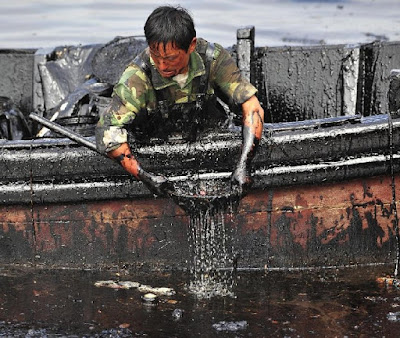Water pollution is the contamination of water bodies (e.g. lakes, rivers, oceans, aquifers and groundwater). This form of environmental degradation occurs when pollutants are directly or indirectly discharged into water bodies without adequate treatment to remove harmful compounds. Water pollution affects the entire biosphere – plants and organisms living in these bodies of water. In almost all cases the effect is damaging not only to individual species and population, but also to the natural biological communities.
Water pollution is a major global problem which requires ongoing evaluation and revision of water resource policy at all levels (international down to individual aquifers and wells). It has been suggested that water pollution is the leading worldwide cause of deaths and diseases, and that it accounts for the deaths of more than 14,000 people daily. An estimated 580 people in India die of water pollution related illness every day. Around 90% the water in the cities of China is polluted, and as of 2007, half a billion Chinese had no access to safe drinking water. In addition to the acute problems of water pollution in developing countries, developed countries also continue to struggle with pollution problems. For example, in the most recent national report on water quality in the United States, 45 percent of assessed stream miles, 47% of assessed lake acres, and 32 percent of assessed bays and estuarine square miles were classified as polluted. The head of China's national development agency said in 2007 that one quarter the length of China's seven main rivers were so poisoned the water harmed the skin.
Although interrelated, surface water and groundwater have often been studied and managed as separate resources.[8] Surface water seeps through the soil and becomes groundwater. Conversely, groundwater can also feed surface water sources. Sources of surface water pollution are generally grouped into two categories based on their origin.
Interactions between groundwater and surface water are complex. Consequently, groundwater pollution, sometimes referred to as groundwater contamination, is not as easily classified as surface water pollution. By its very nature, groundwater aquifers are susceptible to contamination from sources that may not directly affect surface water bodies, and the distinction of point vs. non-point source may be irrelevant. A spill or ongoing release of chemical or radionuclide contaminants into soil (located away from a surface water body) may not create point or non-point source pollution but can contaminate the aquifer below, creating a toxic plume. The movement of the plume, called a plume front, may be analyzed through a hydrological transport model or groundwater model. Analysis of groundwater contamination may focus on soil characteristics and site geology, hydrogeology, hydrology, and the nature of the contaminants.
The specific contaminants leading to pollution in water include a wide spectrum of chemicals, pathogens, and physical changes such as elevated temperature and discoloration. While many of the chemicals and substances that are regulated may be naturally occurring (calcium, sodium, iron, manganese, etc.) the concentration is often the key in determining what is a natural component of water and what is a contaminant. High concentrations of naturally occurring substances can have negative impacts on aquatic flora and fauna.
Many of the chemical substances are toxic. Pathogens can produce waterborne diseases in either human or animal hosts. Alteration of water's physical chemistry includes acidity (change in pH), electrical conductivity, temperature, and eutrophication. Eutrophication is an increase in the concentration of chemical nutrients in an ecosystem to an extent that increases in the primary productivity of the ecosystem. Depending on the degree of eutrophication, subsequent negative environmental effects such as anoxia (oxygen depletion) and severe reductions in water quality may occur, affecting fish and other animal populations.
Most water pollutants are eventually carried by rivers into the oceans. In some areas of the world the influence can be traced one hundred miles from the mouth by studies using hydrology transport models. Advanced computer models such as SWMM or the DSSAM Model have been used in many locations worldwide to examine the fate of pollutants in aquatic systems. Indicator filter feeding species such as copepods have also been used to study pollutant fates in the New York Bight, for example. The highest toxin loads are not directly at the mouth of the Hudson River, but 100 km (62 mi) south, since several days are required for incorporation into planktonic tissue. The Hudson discharge flows south along the coast due to the coriolis force. Further south are areas of oxygen depletion caused by chemicals using up oxygen and by algae blooms, caused by excess nutrients from algal cell death and decomposition. Fish and shellfish kills have been reported, because toxins climb the food chain after small fish consume copepods, then large fish eat smaller fish, etc. Each successive step up the food chain causes a cumulative concentration of pollutants such as heavy metals (e.g. mercury) and persistent organic pollutants such as DDT. This is known as bio-magnification, which is occasionally used interchangeably with bio-accumulation.
Some industrial facilities generate ordinary domestic sewage that can be treated by municipal facilities. Industries that generate waste water with high concentrations of conventional pollutants (e.g. oil and grease), toxic pollutants (e.g. heavy metals, volatile organic compounds) or other non-conventional pollutants such as ammonia, need specialized treatment systems. Some of these facilities can install a pre-treatment system to remove the toxic components, and then send the partially treated waste water to the municipal system. Industries generating large volumes of waste water typically operate their own complete on-site treatment systems. Some industries have been successful at redesigning their manufacturing processes to reduce or eliminate pollutants, through a process called pollution prevention.




















.jpg)
0 Comments